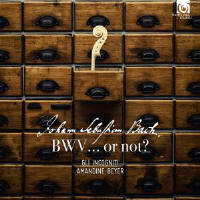Texte paru dans: / Appeared in:
Harmonia Mundi |
|
|
Reviewer: Michael
De Sapio Listening to this program of (mostly) spurious compositions from the Bach catalog, one is continually amazed that a particular selection could have been attributed to Johann Sebastian Bach. The D-Minor Violin Sonata, BWV 1036, has all the quirks of Sebastian’s son Carl Philipp Emmanuel, and it has been rightly reattributed to him. The bizarre Violin Sonata in C Minor which has found its way into the catalog as BWV 1024 sounds sometimes like imperfectly digested Bach, sometimes like Germanicized Vivaldi. It is now attributed to Georg Pisendel, which seems credible given the style. Truth be told, I’ve always found it more interesting than good. The G-Major Trio Sonata, BWV 1038, may have been a collaboration between Sebastian and Emmanuel, perhaps with the father writing the bass line and the son supplying the upper parts. (Incidentally, the identical bass line forms the basis of the Violin Sonata in G Major, BWV 1021.)
If you thought the C-Major
Trio Sonata, BWV 1037, sounded like the work of an earnest student, you’d be
right—it is now attributed to Bach’s composition pupil Johann Gottlieb
Goldberg (of the Goldberg Variations). The piece has its moments—the canonic
slow movement and the tripping gigue finale both show skill—but it is not
quite on the level of J. S. B. The fact that Bach composed so few genuine
trio sonatas is a source of frustration to many musicians, who often run to
these works or to transcriptions to fill in the gap.
Some passages in the Fuga in G
Minor, BWV 1026, presage later Bach violin works, which points to it being
an early work of Johann Sebastian; but the jury is still out. The program
ends with a piece of undisputed Bach—and a masterpiece at that—the Trio
Sonata in C Minor from The Musical Offering. It is included on the basis
that its main theme was suggested by the music-loving sovereign who
commissioned it.
That only leaves the first
selection on the disc, two movements from a Suite in A for Violin and
Continuo which is now recognized as a transcription by Bach of a lute work
by Silvius Leopold Weiss. The notes inform us that the entire suite could
not be included because of time constraints (the disc runs to 79:55). This
is unfortunate.
Amandine Beyer is game to all
the twists and turns in the music, but there is a nervy, aggressive edge to
her tone that does not wear well, especially when recorded as close up as
she is here. Excessively reverberant recorded sound together with overly
fast tempos for some of the movements cause passage work to become hectic
and muddled. The recording favors Beyer at the expense of the flutist, and
when the “King’s theme” appears in the cello in the Trio Sonata it is
swamped by all the busy-work that surrounds it. An interesting program, then, but not very successful performances. I believe the early music movement’s epitaph will read: “Done in by an overdose of adrenaline.” | |
|
|
|
|
|
|
|
Cliquez l'un ou l'autre
bouton pour découvrir bien d'autres critiques de CD |
|




